Cross-Cultural Management: HG Project in Tanzania Report and Analysis
VerifiedAdded on 2022/12/05
|10
|2873
|416
Report
AI Summary
This report presents a comprehensive analysis of a cross-cultural management case study involving Hydro Generation (HG) in Tanzania. The report delves into the challenges faced by HG, focusing on the impact of national culture, organizational structure, and ethics and corporate social responsibility (CSR) on the project's success. It examines the leadership style of Brett Jones, particularly his use of laissez-faire leadership and the implications of nepotism within the Tanzanian context. The report explores how these factors influenced employee relations, organizational reputation, and overall project outcomes. Furthermore, it applies relevant management theories and provides practical recommendations for HG to improve its cross-cultural management practices, including suggestions for leadership adjustments, ethical considerations, and organizational structure modifications to foster a more effective and sustainable approach to international business operations. The analysis considers the importance of understanding local practices, ethical decision-making, and the development of a suitable organizational structure to achieve project goals while maintaining positive relationships with stakeholders.

Cross Cultural
Management
Management
Paraphrase This Document
Need a fresh take? Get an instant paraphrase of this document with our AI Paraphraser
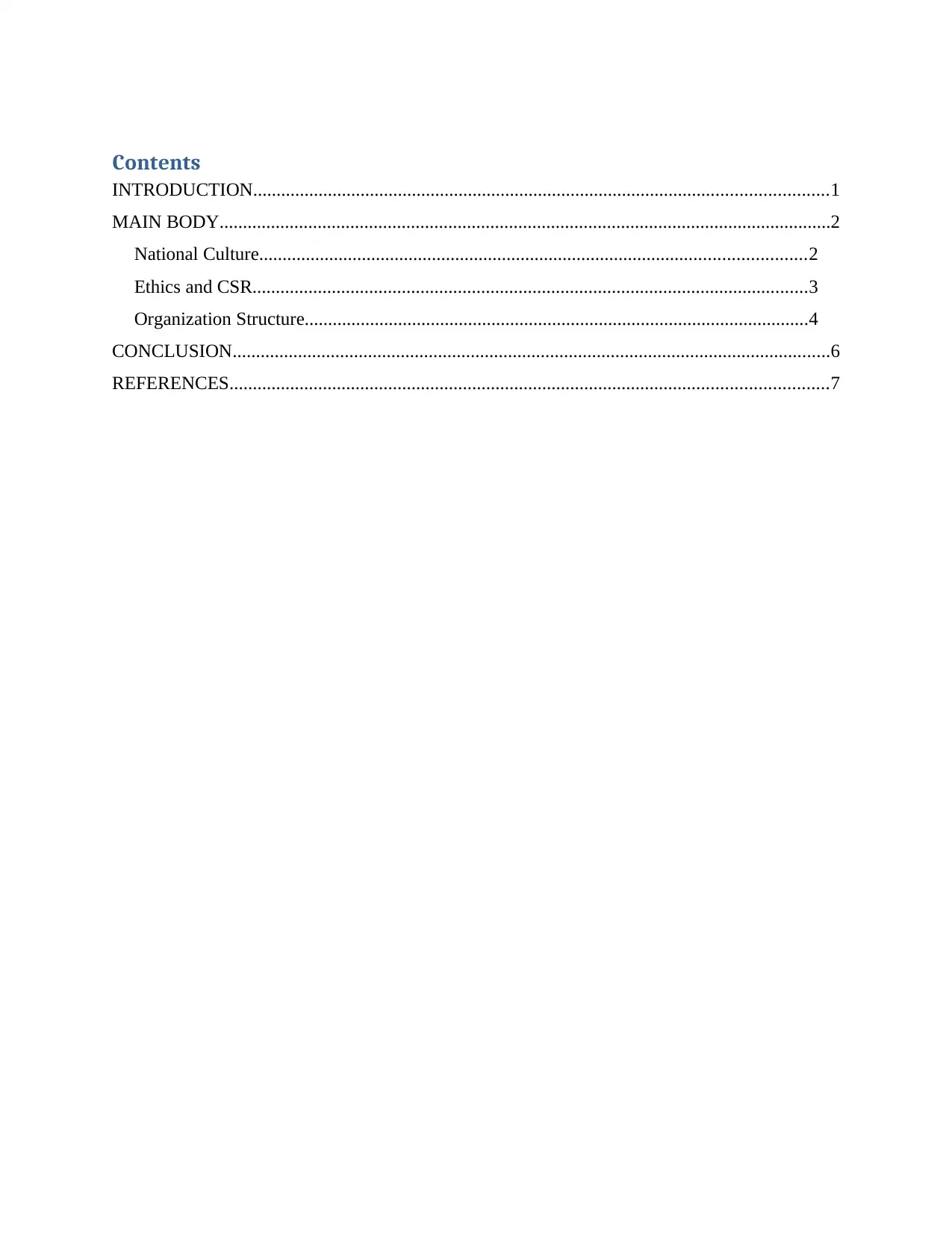
Contents
INTRODUCTION...........................................................................................................................1
MAIN BODY...................................................................................................................................2
National Culture.....................................................................................................................2
Ethics and CSR.......................................................................................................................3
Organization Structure............................................................................................................4
CONCLUSION................................................................................................................................6
REFERENCES................................................................................................................................7
INTRODUCTION...........................................................................................................................1
MAIN BODY...................................................................................................................................2
National Culture.....................................................................................................................2
Ethics and CSR.......................................................................................................................3
Organization Structure............................................................................................................4
CONCLUSION................................................................................................................................6
REFERENCES................................................................................................................................7

⊘ This is a preview!⊘
Do you want full access?
Subscribe today to unlock all pages.

Trusted by 1+ million students worldwide
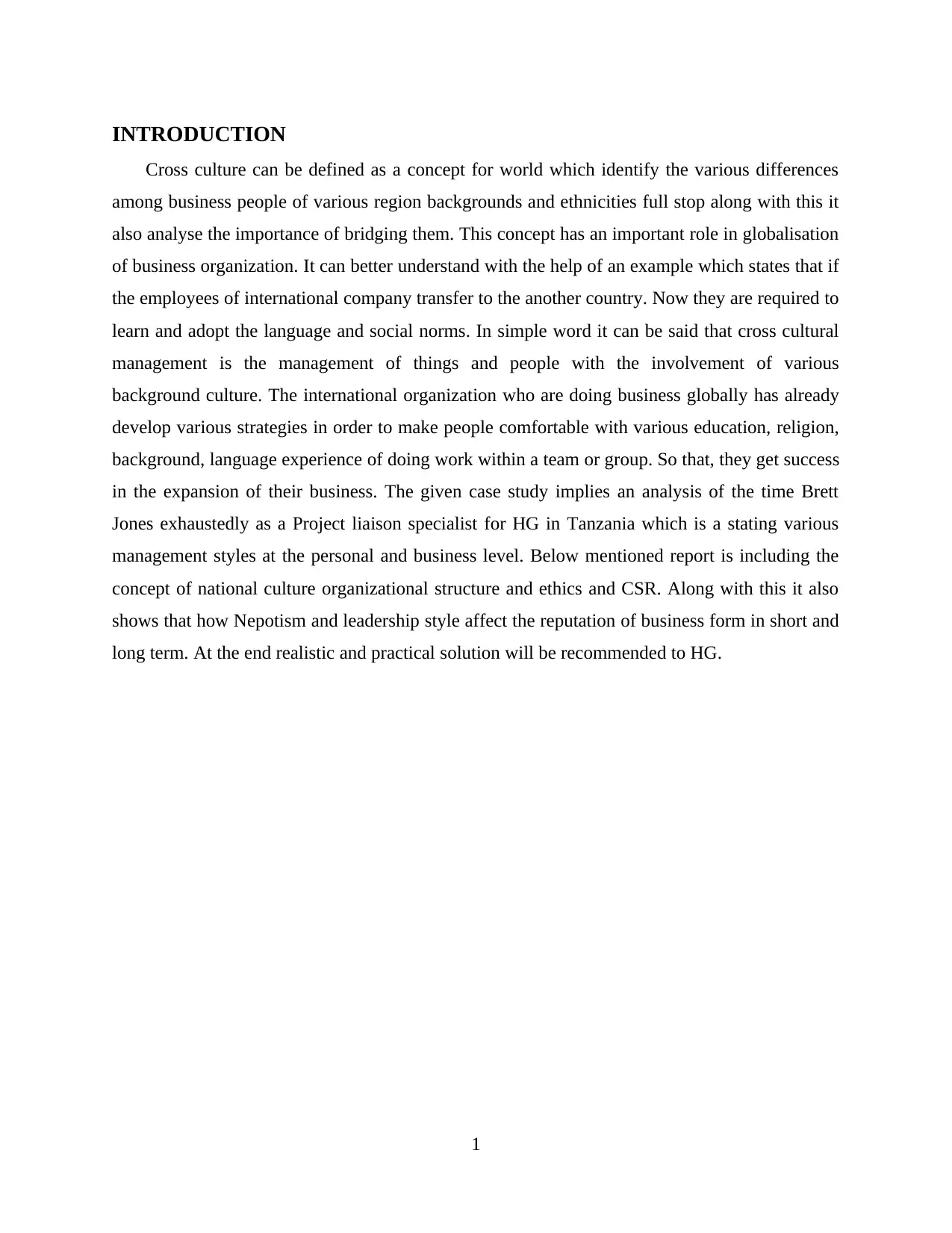
INTRODUCTION
Cross culture can be defined as a concept for world which identify the various differences
among business people of various region backgrounds and ethnicities full stop along with this it
also analyse the importance of bridging them. This concept has an important role in globalisation
of business organization. It can better understand with the help of an example which states that if
the employees of international company transfer to the another country. Now they are required to
learn and adopt the language and social norms. In simple word it can be said that cross cultural
management is the management of things and people with the involvement of various
background culture. The international organization who are doing business globally has already
develop various strategies in order to make people comfortable with various education, religion,
background, language experience of doing work within a team or group. So that, they get success
in the expansion of their business. The given case study implies an analysis of the time Brett
Jones exhaustedly as a Project liaison specialist for HG in Tanzania which is a stating various
management styles at the personal and business level. Below mentioned report is including the
concept of national culture organizational structure and ethics and CSR. Along with this it also
shows that how Nepotism and leadership style affect the reputation of business form in short and
long term. At the end realistic and practical solution will be recommended to HG.
1
Cross culture can be defined as a concept for world which identify the various differences
among business people of various region backgrounds and ethnicities full stop along with this it
also analyse the importance of bridging them. This concept has an important role in globalisation
of business organization. It can better understand with the help of an example which states that if
the employees of international company transfer to the another country. Now they are required to
learn and adopt the language and social norms. In simple word it can be said that cross cultural
management is the management of things and people with the involvement of various
background culture. The international organization who are doing business globally has already
develop various strategies in order to make people comfortable with various education, religion,
background, language experience of doing work within a team or group. So that, they get success
in the expansion of their business. The given case study implies an analysis of the time Brett
Jones exhaustedly as a Project liaison specialist for HG in Tanzania which is a stating various
management styles at the personal and business level. Below mentioned report is including the
concept of national culture organizational structure and ethics and CSR. Along with this it also
shows that how Nepotism and leadership style affect the reputation of business form in short and
long term. At the end realistic and practical solution will be recommended to HG.
1
Paraphrase This Document
Need a fresh take? Get an instant paraphrase of this document with our AI Paraphraser
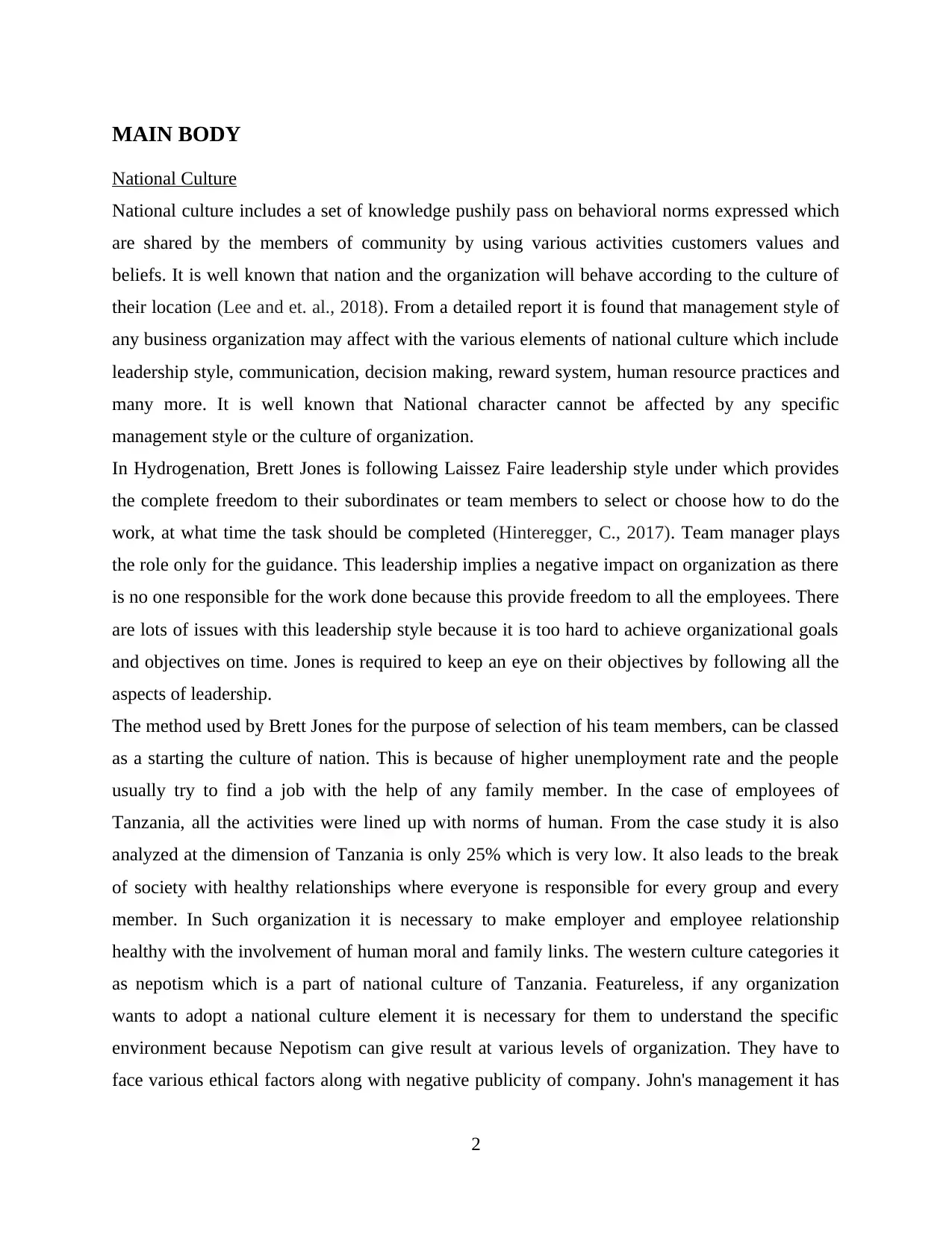
MAIN BODY
National Culture
National culture includes a set of knowledge pushily pass on behavioral norms expressed which
are shared by the members of community by using various activities customers values and
beliefs. It is well known that nation and the organization will behave according to the culture of
their location (Lee and et. al., 2018). From a detailed report it is found that management style of
any business organization may affect with the various elements of national culture which include
leadership style, communication, decision making, reward system, human resource practices and
many more. It is well known that National character cannot be affected by any specific
management style or the culture of organization.
In Hydrogenation, Brett Jones is following Laissez Faire leadership style under which provides
the complete freedom to their subordinates or team members to select or choose how to do the
work, at what time the task should be completed (Hinteregger, C., 2017). Team manager plays
the role only for the guidance. This leadership implies a negative impact on organization as there
is no one responsible for the work done because this provide freedom to all the employees. There
are lots of issues with this leadership style because it is too hard to achieve organizational goals
and objectives on time. Jones is required to keep an eye on their objectives by following all the
aspects of leadership.
The method used by Brett Jones for the purpose of selection of his team members, can be classed
as a starting the culture of nation. This is because of higher unemployment rate and the people
usually try to find a job with the help of any family member. In the case of employees of
Tanzania, all the activities were lined up with norms of human. From the case study it is also
analyzed at the dimension of Tanzania is only 25% which is very low. It also leads to the break
of society with healthy relationships where everyone is responsible for every group and every
member. In Such organization it is necessary to make employer and employee relationship
healthy with the involvement of human moral and family links. The western culture categories it
as nepotism which is a part of national culture of Tanzania. Featureless, if any organization
wants to adopt a national culture element it is necessary for them to understand the specific
environment because Nepotism can give result at various levels of organization. They have to
face various ethical factors along with negative publicity of company. John's management it has
2
National Culture
National culture includes a set of knowledge pushily pass on behavioral norms expressed which
are shared by the members of community by using various activities customers values and
beliefs. It is well known that nation and the organization will behave according to the culture of
their location (Lee and et. al., 2018). From a detailed report it is found that management style of
any business organization may affect with the various elements of national culture which include
leadership style, communication, decision making, reward system, human resource practices and
many more. It is well known that National character cannot be affected by any specific
management style or the culture of organization.
In Hydrogenation, Brett Jones is following Laissez Faire leadership style under which provides
the complete freedom to their subordinates or team members to select or choose how to do the
work, at what time the task should be completed (Hinteregger, C., 2017). Team manager plays
the role only for the guidance. This leadership implies a negative impact on organization as there
is no one responsible for the work done because this provide freedom to all the employees. There
are lots of issues with this leadership style because it is too hard to achieve organizational goals
and objectives on time. Jones is required to keep an eye on their objectives by following all the
aspects of leadership.
The method used by Brett Jones for the purpose of selection of his team members, can be classed
as a starting the culture of nation. This is because of higher unemployment rate and the people
usually try to find a job with the help of any family member. In the case of employees of
Tanzania, all the activities were lined up with norms of human. From the case study it is also
analyzed at the dimension of Tanzania is only 25% which is very low. It also leads to the break
of society with healthy relationships where everyone is responsible for every group and every
member. In Such organization it is necessary to make employer and employee relationship
healthy with the involvement of human moral and family links. The western culture categories it
as nepotism which is a part of national culture of Tanzania. Featureless, if any organization
wants to adopt a national culture element it is necessary for them to understand the specific
environment because Nepotism can give result at various levels of organization. They have to
face various ethical factors along with negative publicity of company. John's management it has
2
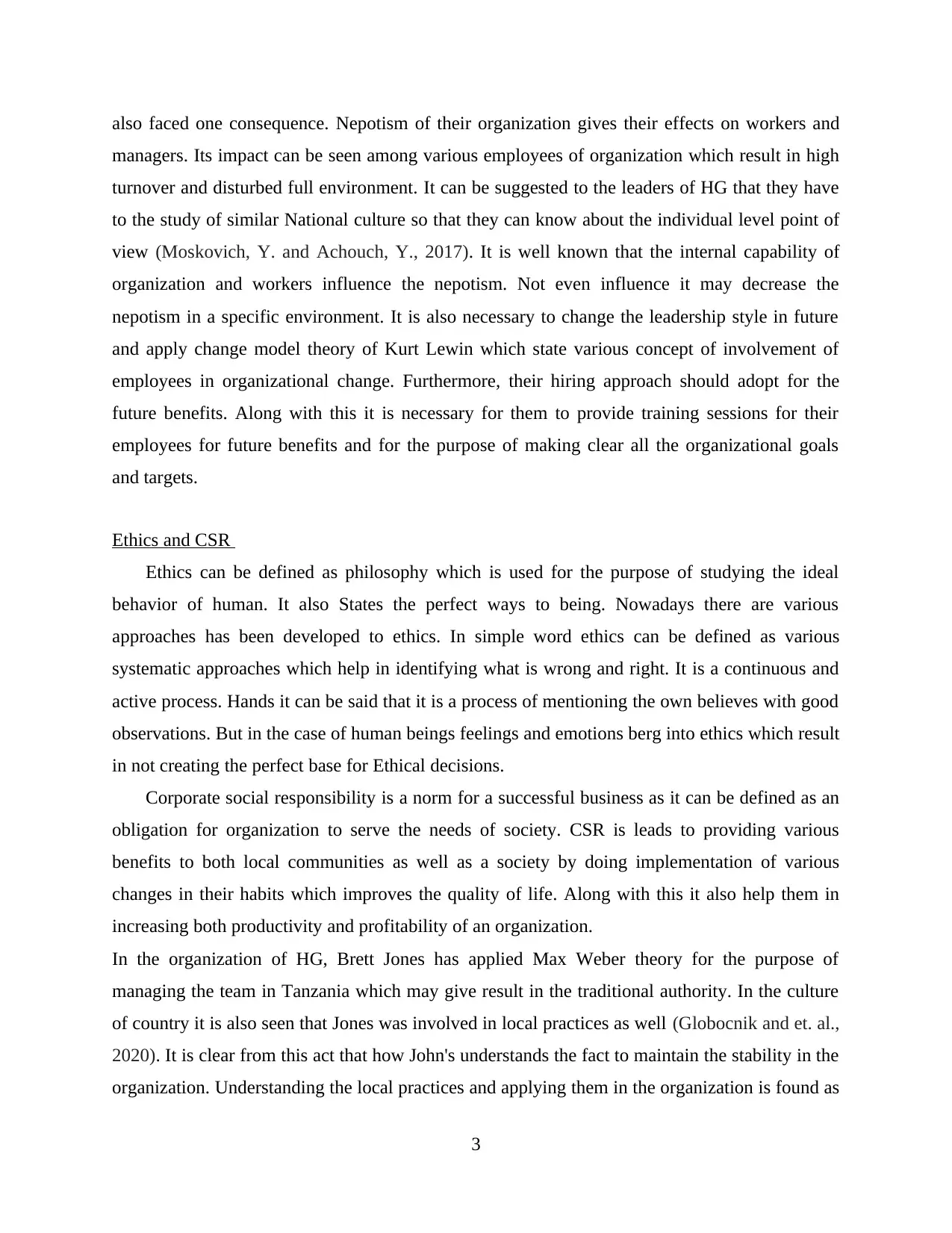
also faced one consequence. Nepotism of their organization gives their effects on workers and
managers. Its impact can be seen among various employees of organization which result in high
turnover and disturbed full environment. It can be suggested to the leaders of HG that they have
to the study of similar National culture so that they can know about the individual level point of
view (Moskovich, Y. and Achouch, Y., 2017). It is well known that the internal capability of
organization and workers influence the nepotism. Not even influence it may decrease the
nepotism in a specific environment. It is also necessary to change the leadership style in future
and apply change model theory of Kurt Lewin which state various concept of involvement of
employees in organizational change. Furthermore, their hiring approach should adopt for the
future benefits. Along with this it is necessary for them to provide training sessions for their
employees for future benefits and for the purpose of making clear all the organizational goals
and targets.
Ethics and CSR
Ethics can be defined as philosophy which is used for the purpose of studying the ideal
behavior of human. It also States the perfect ways to being. Nowadays there are various
approaches has been developed to ethics. In simple word ethics can be defined as various
systematic approaches which help in identifying what is wrong and right. It is a continuous and
active process. Hands it can be said that it is a process of mentioning the own believes with good
observations. But in the case of human beings feelings and emotions berg into ethics which result
in not creating the perfect base for Ethical decisions.
Corporate social responsibility is a norm for a successful business as it can be defined as an
obligation for organization to serve the needs of society. CSR is leads to providing various
benefits to both local communities as well as a society by doing implementation of various
changes in their habits which improves the quality of life. Along with this it also help them in
increasing both productivity and profitability of an organization.
In the organization of HG, Brett Jones has applied Max Weber theory for the purpose of
managing the team in Tanzania which may give result in the traditional authority. In the culture
of country it is also seen that Jones was involved in local practices as well (Globocnik and et. al.,
2020). It is clear from this act that how John's understands the fact to maintain the stability in the
organization. Understanding the local practices and applying them in the organization is found as
3
managers. Its impact can be seen among various employees of organization which result in high
turnover and disturbed full environment. It can be suggested to the leaders of HG that they have
to the study of similar National culture so that they can know about the individual level point of
view (Moskovich, Y. and Achouch, Y., 2017). It is well known that the internal capability of
organization and workers influence the nepotism. Not even influence it may decrease the
nepotism in a specific environment. It is also necessary to change the leadership style in future
and apply change model theory of Kurt Lewin which state various concept of involvement of
employees in organizational change. Furthermore, their hiring approach should adopt for the
future benefits. Along with this it is necessary for them to provide training sessions for their
employees for future benefits and for the purpose of making clear all the organizational goals
and targets.
Ethics and CSR
Ethics can be defined as philosophy which is used for the purpose of studying the ideal
behavior of human. It also States the perfect ways to being. Nowadays there are various
approaches has been developed to ethics. In simple word ethics can be defined as various
systematic approaches which help in identifying what is wrong and right. It is a continuous and
active process. Hands it can be said that it is a process of mentioning the own believes with good
observations. But in the case of human beings feelings and emotions berg into ethics which result
in not creating the perfect base for Ethical decisions.
Corporate social responsibility is a norm for a successful business as it can be defined as an
obligation for organization to serve the needs of society. CSR is leads to providing various
benefits to both local communities as well as a society by doing implementation of various
changes in their habits which improves the quality of life. Along with this it also help them in
increasing both productivity and profitability of an organization.
In the organization of HG, Brett Jones has applied Max Weber theory for the purpose of
managing the team in Tanzania which may give result in the traditional authority. In the culture
of country it is also seen that Jones was involved in local practices as well (Globocnik and et. al.,
2020). It is clear from this act that how John's understands the fact to maintain the stability in the
organization. Understanding the local practices and applying them in the organization is found as
3
⊘ This is a preview!⊘
Do you want full access?
Subscribe today to unlock all pages.

Trusted by 1+ million students worldwide
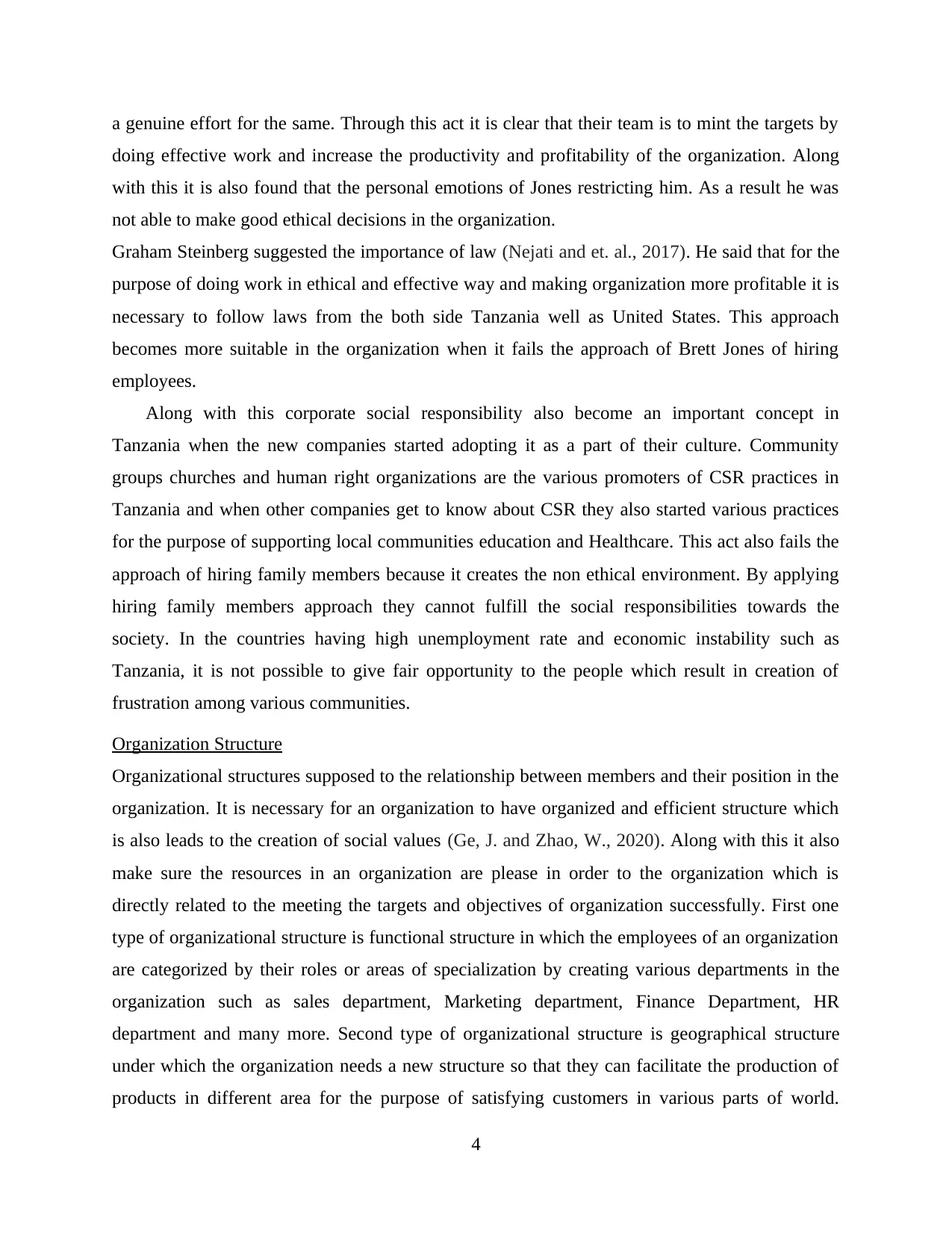
a genuine effort for the same. Through this act it is clear that their team is to mint the targets by
doing effective work and increase the productivity and profitability of the organization. Along
with this it is also found that the personal emotions of Jones restricting him. As a result he was
not able to make good ethical decisions in the organization.
Graham Steinberg suggested the importance of law (Nejati and et. al., 2017). He said that for the
purpose of doing work in ethical and effective way and making organization more profitable it is
necessary to follow laws from the both side Tanzania well as United States. This approach
becomes more suitable in the organization when it fails the approach of Brett Jones of hiring
employees.
Along with this corporate social responsibility also become an important concept in
Tanzania when the new companies started adopting it as a part of their culture. Community
groups churches and human right organizations are the various promoters of CSR practices in
Tanzania and when other companies get to know about CSR they also started various practices
for the purpose of supporting local communities education and Healthcare. This act also fails the
approach of hiring family members because it creates the non ethical environment. By applying
hiring family members approach they cannot fulfill the social responsibilities towards the
society. In the countries having high unemployment rate and economic instability such as
Tanzania, it is not possible to give fair opportunity to the people which result in creation of
frustration among various communities.
Organization Structure
Organizational structures supposed to the relationship between members and their position in the
organization. It is necessary for an organization to have organized and efficient structure which
is also leads to the creation of social values (Ge, J. and Zhao, W., 2020). Along with this it also
make sure the resources in an organization are please in order to the organization which is
directly related to the meeting the targets and objectives of organization successfully. First one
type of organizational structure is functional structure in which the employees of an organization
are categorized by their roles or areas of specialization by creating various departments in the
organization such as sales department, Marketing department, Finance Department, HR
department and many more. Second type of organizational structure is geographical structure
under which the organization needs a new structure so that they can facilitate the production of
products in different area for the purpose of satisfying customers in various parts of world.
4
doing effective work and increase the productivity and profitability of the organization. Along
with this it is also found that the personal emotions of Jones restricting him. As a result he was
not able to make good ethical decisions in the organization.
Graham Steinberg suggested the importance of law (Nejati and et. al., 2017). He said that for the
purpose of doing work in ethical and effective way and making organization more profitable it is
necessary to follow laws from the both side Tanzania well as United States. This approach
becomes more suitable in the organization when it fails the approach of Brett Jones of hiring
employees.
Along with this corporate social responsibility also become an important concept in
Tanzania when the new companies started adopting it as a part of their culture. Community
groups churches and human right organizations are the various promoters of CSR practices in
Tanzania and when other companies get to know about CSR they also started various practices
for the purpose of supporting local communities education and Healthcare. This act also fails the
approach of hiring family members because it creates the non ethical environment. By applying
hiring family members approach they cannot fulfill the social responsibilities towards the
society. In the countries having high unemployment rate and economic instability such as
Tanzania, it is not possible to give fair opportunity to the people which result in creation of
frustration among various communities.
Organization Structure
Organizational structures supposed to the relationship between members and their position in the
organization. It is necessary for an organization to have organized and efficient structure which
is also leads to the creation of social values (Ge, J. and Zhao, W., 2020). Along with this it also
make sure the resources in an organization are please in order to the organization which is
directly related to the meeting the targets and objectives of organization successfully. First one
type of organizational structure is functional structure in which the employees of an organization
are categorized by their roles or areas of specialization by creating various departments in the
organization such as sales department, Marketing department, Finance Department, HR
department and many more. Second type of organizational structure is geographical structure
under which the organization needs a new structure so that they can facilitate the production of
products in different area for the purpose of satisfying customers in various parts of world.
4
Paraphrase This Document
Need a fresh take? Get an instant paraphrase of this document with our AI Paraphraser
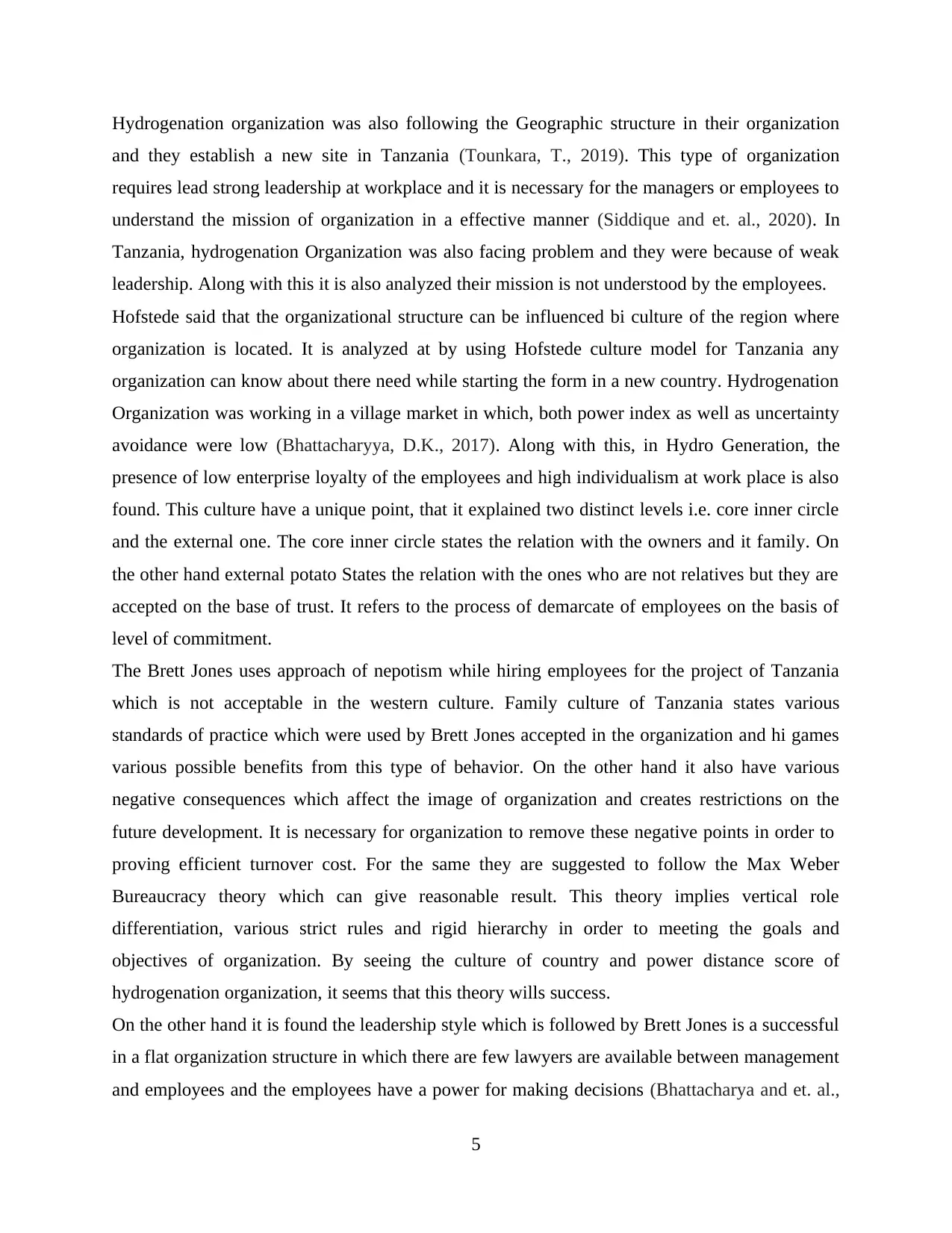
Hydrogenation organization was also following the Geographic structure in their organization
and they establish a new site in Tanzania (Tounkara, T., 2019). This type of organization
requires lead strong leadership at workplace and it is necessary for the managers or employees to
understand the mission of organization in a effective manner (Siddique and et. al., 2020). In
Tanzania, hydrogenation Organization was also facing problem and they were because of weak
leadership. Along with this it is also analyzed their mission is not understood by the employees.
Hofstede said that the organizational structure can be influenced bi culture of the region where
organization is located. It is analyzed at by using Hofstede culture model for Tanzania any
organization can know about there need while starting the form in a new country. Hydrogenation
Organization was working in a village market in which, both power index as well as uncertainty
avoidance were low (Bhattacharyya, D.K., 2017). Along with this, in Hydro Generation, the
presence of low enterprise loyalty of the employees and high individualism at work place is also
found. This culture have a unique point, that it explained two distinct levels i.e. core inner circle
and the external one. The core inner circle states the relation with the owners and it family. On
the other hand external potato States the relation with the ones who are not relatives but they are
accepted on the base of trust. It refers to the process of demarcate of employees on the basis of
level of commitment.
The Brett Jones uses approach of nepotism while hiring employees for the project of Tanzania
which is not acceptable in the western culture. Family culture of Tanzania states various
standards of practice which were used by Brett Jones accepted in the organization and hi games
various possible benefits from this type of behavior. On the other hand it also have various
negative consequences which affect the image of organization and creates restrictions on the
future development. It is necessary for organization to remove these negative points in order to
proving efficient turnover cost. For the same they are suggested to follow the Max Weber
Bureaucracy theory which can give reasonable result. This theory implies vertical role
differentiation, various strict rules and rigid hierarchy in order to meeting the goals and
objectives of organization. By seeing the culture of country and power distance score of
hydrogenation organization, it seems that this theory wills success.
On the other hand it is found the leadership style which is followed by Brett Jones is a successful
in a flat organization structure in which there are few lawyers are available between management
and employees and the employees have a power for making decisions (Bhattacharya and et. al.,
5
and they establish a new site in Tanzania (Tounkara, T., 2019). This type of organization
requires lead strong leadership at workplace and it is necessary for the managers or employees to
understand the mission of organization in a effective manner (Siddique and et. al., 2020). In
Tanzania, hydrogenation Organization was also facing problem and they were because of weak
leadership. Along with this it is also analyzed their mission is not understood by the employees.
Hofstede said that the organizational structure can be influenced bi culture of the region where
organization is located. It is analyzed at by using Hofstede culture model for Tanzania any
organization can know about there need while starting the form in a new country. Hydrogenation
Organization was working in a village market in which, both power index as well as uncertainty
avoidance were low (Bhattacharyya, D.K., 2017). Along with this, in Hydro Generation, the
presence of low enterprise loyalty of the employees and high individualism at work place is also
found. This culture have a unique point, that it explained two distinct levels i.e. core inner circle
and the external one. The core inner circle states the relation with the owners and it family. On
the other hand external potato States the relation with the ones who are not relatives but they are
accepted on the base of trust. It refers to the process of demarcate of employees on the basis of
level of commitment.
The Brett Jones uses approach of nepotism while hiring employees for the project of Tanzania
which is not acceptable in the western culture. Family culture of Tanzania states various
standards of practice which were used by Brett Jones accepted in the organization and hi games
various possible benefits from this type of behavior. On the other hand it also have various
negative consequences which affect the image of organization and creates restrictions on the
future development. It is necessary for organization to remove these negative points in order to
proving efficient turnover cost. For the same they are suggested to follow the Max Weber
Bureaucracy theory which can give reasonable result. This theory implies vertical role
differentiation, various strict rules and rigid hierarchy in order to meeting the goals and
objectives of organization. By seeing the culture of country and power distance score of
hydrogenation organization, it seems that this theory wills success.
On the other hand it is found the leadership style which is followed by Brett Jones is a successful
in a flat organization structure in which there are few lawyers are available between management
and employees and the employees have a power for making decisions (Bhattacharya and et. al.,
5
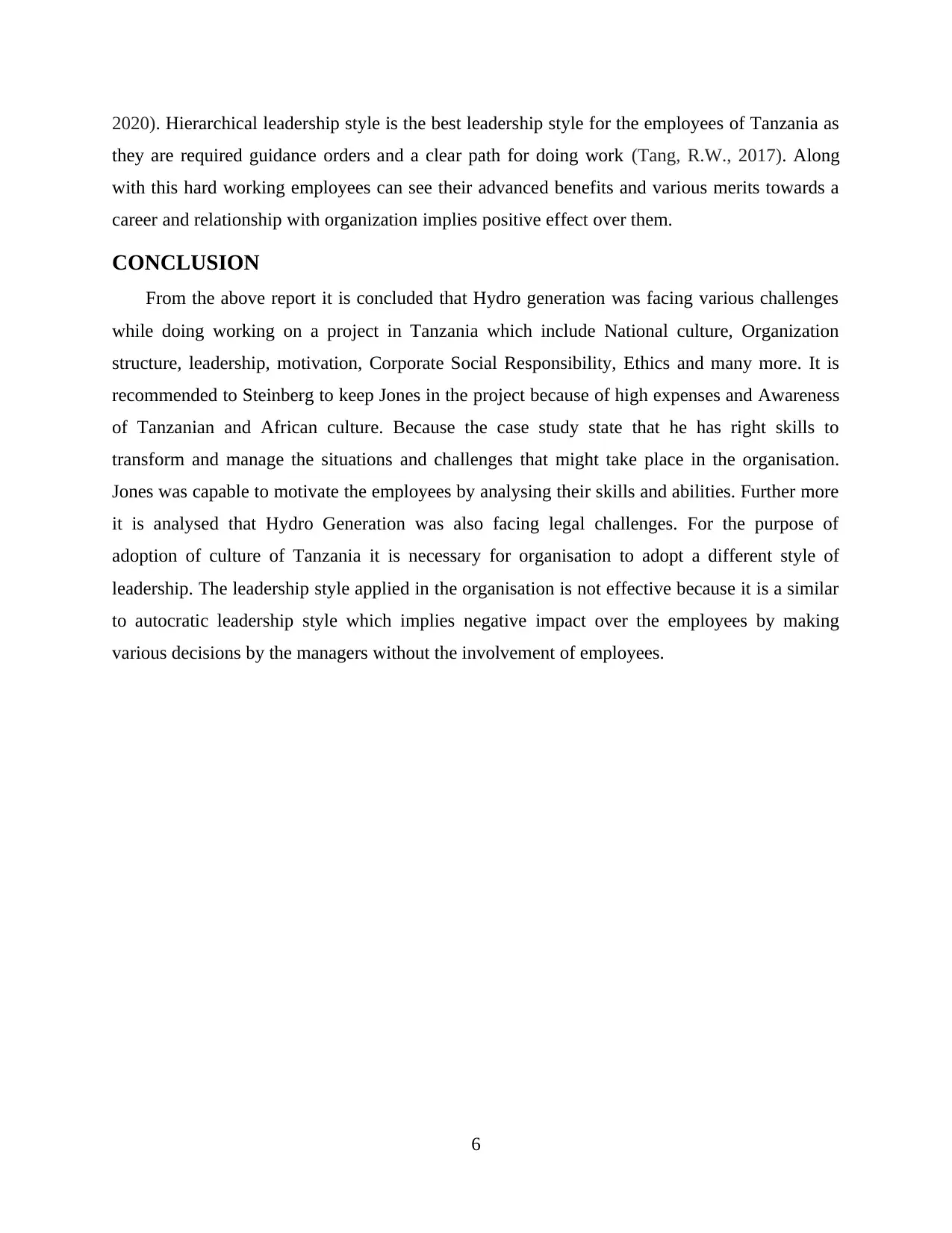
2020). Hierarchical leadership style is the best leadership style for the employees of Tanzania as
they are required guidance orders and a clear path for doing work (Tang, R.W., 2017). Along
with this hard working employees can see their advanced benefits and various merits towards a
career and relationship with organization implies positive effect over them.
CONCLUSION
From the above report it is concluded that Hydro generation was facing various challenges
while doing working on a project in Tanzania which include National culture, Organization
structure, leadership, motivation, Corporate Social Responsibility, Ethics and many more. It is
recommended to Steinberg to keep Jones in the project because of high expenses and Awareness
of Tanzanian and African culture. Because the case study state that he has right skills to
transform and manage the situations and challenges that might take place in the organisation.
Jones was capable to motivate the employees by analysing their skills and abilities. Further more
it is analysed that Hydro Generation was also facing legal challenges. For the purpose of
adoption of culture of Tanzania it is necessary for organisation to adopt a different style of
leadership. The leadership style applied in the organisation is not effective because it is a similar
to autocratic leadership style which implies negative impact over the employees by making
various decisions by the managers without the involvement of employees.
6
they are required guidance orders and a clear path for doing work (Tang, R.W., 2017). Along
with this hard working employees can see their advanced benefits and various merits towards a
career and relationship with organization implies positive effect over them.
CONCLUSION
From the above report it is concluded that Hydro generation was facing various challenges
while doing working on a project in Tanzania which include National culture, Organization
structure, leadership, motivation, Corporate Social Responsibility, Ethics and many more. It is
recommended to Steinberg to keep Jones in the project because of high expenses and Awareness
of Tanzanian and African culture. Because the case study state that he has right skills to
transform and manage the situations and challenges that might take place in the organisation.
Jones was capable to motivate the employees by analysing their skills and abilities. Further more
it is analysed that Hydro Generation was also facing legal challenges. For the purpose of
adoption of culture of Tanzania it is necessary for organisation to adopt a different style of
leadership. The leadership style applied in the organisation is not effective because it is a similar
to autocratic leadership style which implies negative impact over the employees by making
various decisions by the managers without the involvement of employees.
6
⊘ This is a preview!⊘
Do you want full access?
Subscribe today to unlock all pages.

Trusted by 1+ million students worldwide
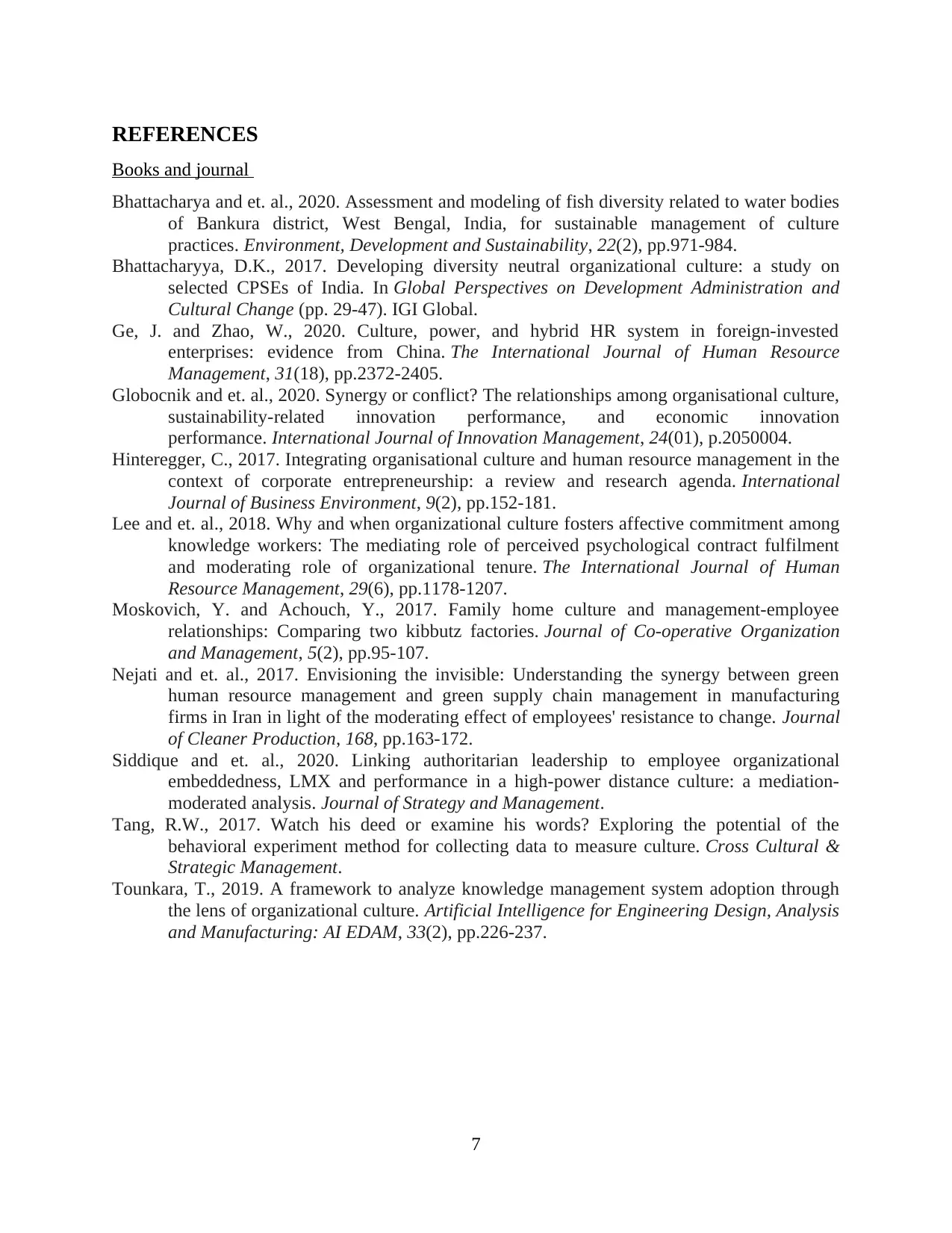
REFERENCES
Books and journal
Bhattacharya and et. al., 2020. Assessment and modeling of fish diversity related to water bodies
of Bankura district, West Bengal, India, for sustainable management of culture
practices. Environment, Development and Sustainability, 22(2), pp.971-984.
Bhattacharyya, D.K., 2017. Developing diversity neutral organizational culture: a study on
selected CPSEs of India. In Global Perspectives on Development Administration and
Cultural Change (pp. 29-47). IGI Global.
Ge, J. and Zhao, W., 2020. Culture, power, and hybrid HR system in foreign-invested
enterprises: evidence from China. The International Journal of Human Resource
Management, 31(18), pp.2372-2405.
Globocnik and et. al., 2020. Synergy or conflict? The relationships among organisational culture,
sustainability-related innovation performance, and economic innovation
performance. International Journal of Innovation Management, 24(01), p.2050004.
Hinteregger, C., 2017. Integrating organisational culture and human resource management in the
context of corporate entrepreneurship: a review and research agenda. International
Journal of Business Environment, 9(2), pp.152-181.
Lee and et. al., 2018. Why and when organizational culture fosters affective commitment among
knowledge workers: The mediating role of perceived psychological contract fulfilment
and moderating role of organizational tenure. The International Journal of Human
Resource Management, 29(6), pp.1178-1207.
Moskovich, Y. and Achouch, Y., 2017. Family home culture and management-employee
relationships: Comparing two kibbutz factories. Journal of Co-operative Organization
and Management, 5(2), pp.95-107.
Nejati and et. al., 2017. Envisioning the invisible: Understanding the synergy between green
human resource management and green supply chain management in manufacturing
firms in Iran in light of the moderating effect of employees' resistance to change. Journal
of Cleaner Production, 168, pp.163-172.
Siddique and et. al., 2020. Linking authoritarian leadership to employee organizational
embeddedness, LMX and performance in a high-power distance culture: a mediation-
moderated analysis. Journal of Strategy and Management.
Tang, R.W., 2017. Watch his deed or examine his words? Exploring the potential of the
behavioral experiment method for collecting data to measure culture. Cross Cultural &
Strategic Management.
Tounkara, T., 2019. A framework to analyze knowledge management system adoption through
the lens of organizational culture. Artificial Intelligence for Engineering Design, Analysis
and Manufacturing: AI EDAM, 33(2), pp.226-237.
7
Books and journal
Bhattacharya and et. al., 2020. Assessment and modeling of fish diversity related to water bodies
of Bankura district, West Bengal, India, for sustainable management of culture
practices. Environment, Development and Sustainability, 22(2), pp.971-984.
Bhattacharyya, D.K., 2017. Developing diversity neutral organizational culture: a study on
selected CPSEs of India. In Global Perspectives on Development Administration and
Cultural Change (pp. 29-47). IGI Global.
Ge, J. and Zhao, W., 2020. Culture, power, and hybrid HR system in foreign-invested
enterprises: evidence from China. The International Journal of Human Resource
Management, 31(18), pp.2372-2405.
Globocnik and et. al., 2020. Synergy or conflict? The relationships among organisational culture,
sustainability-related innovation performance, and economic innovation
performance. International Journal of Innovation Management, 24(01), p.2050004.
Hinteregger, C., 2017. Integrating organisational culture and human resource management in the
context of corporate entrepreneurship: a review and research agenda. International
Journal of Business Environment, 9(2), pp.152-181.
Lee and et. al., 2018. Why and when organizational culture fosters affective commitment among
knowledge workers: The mediating role of perceived psychological contract fulfilment
and moderating role of organizational tenure. The International Journal of Human
Resource Management, 29(6), pp.1178-1207.
Moskovich, Y. and Achouch, Y., 2017. Family home culture and management-employee
relationships: Comparing two kibbutz factories. Journal of Co-operative Organization
and Management, 5(2), pp.95-107.
Nejati and et. al., 2017. Envisioning the invisible: Understanding the synergy between green
human resource management and green supply chain management in manufacturing
firms in Iran in light of the moderating effect of employees' resistance to change. Journal
of Cleaner Production, 168, pp.163-172.
Siddique and et. al., 2020. Linking authoritarian leadership to employee organizational
embeddedness, LMX and performance in a high-power distance culture: a mediation-
moderated analysis. Journal of Strategy and Management.
Tang, R.W., 2017. Watch his deed or examine his words? Exploring the potential of the
behavioral experiment method for collecting data to measure culture. Cross Cultural &
Strategic Management.
Tounkara, T., 2019. A framework to analyze knowledge management system adoption through
the lens of organizational culture. Artificial Intelligence for Engineering Design, Analysis
and Manufacturing: AI EDAM, 33(2), pp.226-237.
7
1 out of 10
Related Documents
Your All-in-One AI-Powered Toolkit for Academic Success.
+13062052269
info@desklib.com
Available 24*7 on WhatsApp / Email
![[object Object]](/_next/static/media/star-bottom.7253800d.svg)
Unlock your academic potential
Copyright © 2020–2025 A2Z Services. All Rights Reserved. Developed and managed by ZUCOL.




